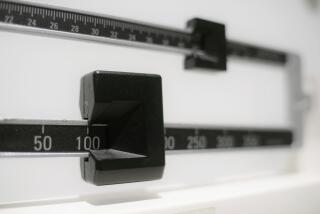Research Casts Shadow on ‘Exercise Lite’
- Share via
WASHINGTON — Don’t count on a little exercise to make you lose a little weight.
“We found that weight loss is nonexistent or extremely modest,” researcher Joe Donnelly says.
Donnelly’s lab looked at the value of guidelines from the federal Centers for Disease Control and Prevention and the American College of Sports Medicine. The recommendations call for moderate activity, such as a brisk walk, for 30 minutes a day on at least most days of the week. The 30 minutes can, if needed, be broken into as many as three sessions of 10 minutes each.
Researchers at the University of Nebraska-Kearney tested whether people could lose weight with 30 minutes of continuous work or with two 15-minute sessions.
The scientists divided 37 moderately obese middle-age adults into two roughly equal groups and put them in walking programs that fit the CDC-ACSM rules. The exercisers did not alter their usual eating habits.
After six months, both groups weighed about as much as they did when they started, said researcher Nancy Richards. This wasn’t surprising, because they probably burned no more than 200 extra calories on exercise days, she said.
“If a person is using exercise for weight loss, you are going to have to increase the dosage,” said Donnelly, a former Nebraska-Kearney researcher who chairs the health sciences department at the University of Kansas.
The CDC-ACSM approach, sometimes called “exercise lite,” targets people who do no exercise. Experts hope that getting these people to set foot on the walking path could start them toward more intense exercise. And they believe that people who can’t spare 30 minutes in one session might do that much in several smaller time periods.
But there’s no strong evidence that spacing exercise encourages people to work out, and there are indications that the opposite is taking place, Donnelly said. In a not-yet-published 18-month study, a group that did two 15-minute sessions initially was more likely to still be exercising after nine months. But, after 16 months, a different group that piled its workout into one 30-minute session stuck with it more, he said.
Other research indicates that combining diet with exercise can shed some pounds.
“We know that exercise is one of the single best predictors of who will lose weight and maintain the loss long-term,” said John M. Jakicic of the University of Pittsburgh School of Medicine. In one six-month project, people weighing an average of 200 pounds lost about 20 pounds on a combination of moderate exercise and a diet of 1,200 to 1,500 calories a day.
“The majority would be accounted for by diet,” Jakicic said. “But exercise gives them room to cheat on the diet a bit.”
Even if “exercise lite” doesn’t help people lose weight, it does seem to help them avoid gaining, Richards said. This could be especially important as people age, when they normally add fat and lose muscle, she said: “If this allows people to maintain weight, that’s not bad.”
And even if people stay overweight, the exercise gives them a better chance to avoid an untimely death, said Carolyn E. Barlow of the Cooper Institute of Aerobics Research in Dallas. Her study looked at death rates of 25,389 men examined at the clinic who were followed, on average, for 8 1/2 years. Even moderately fit overweight men had about half the death rate of non-fit men, the study found.






